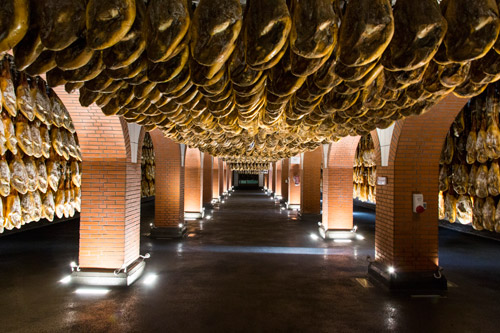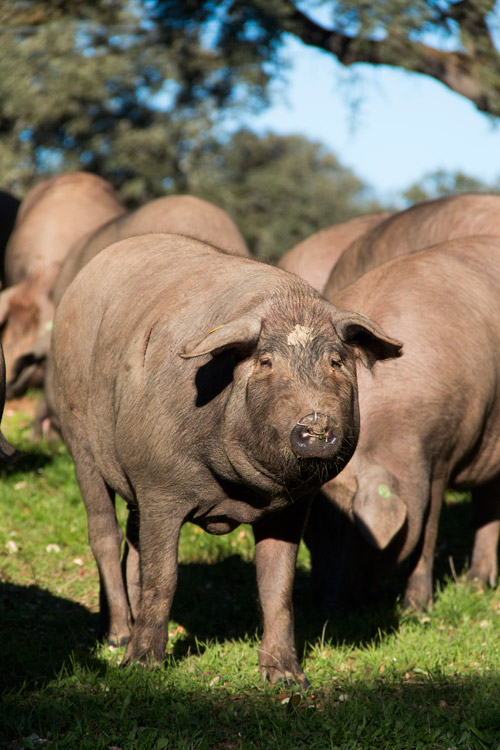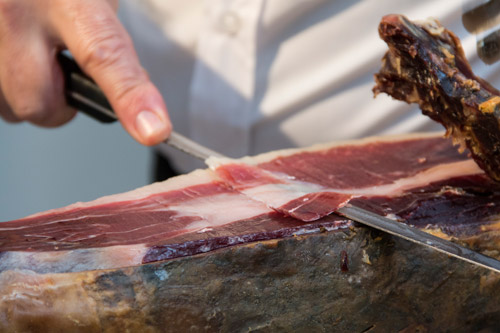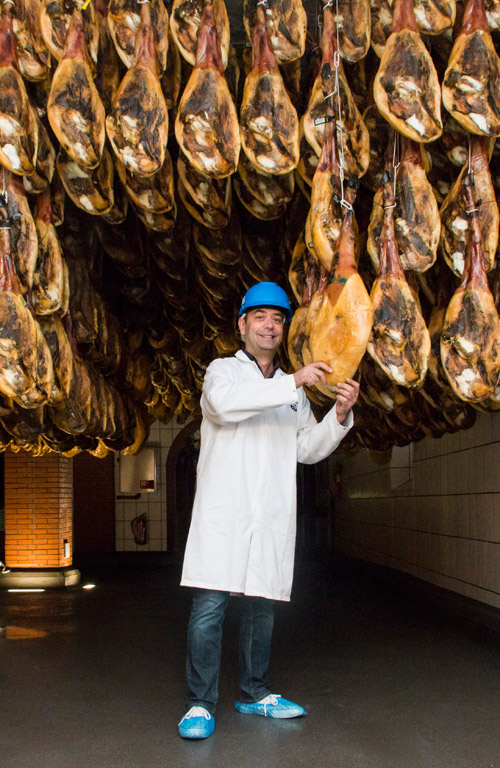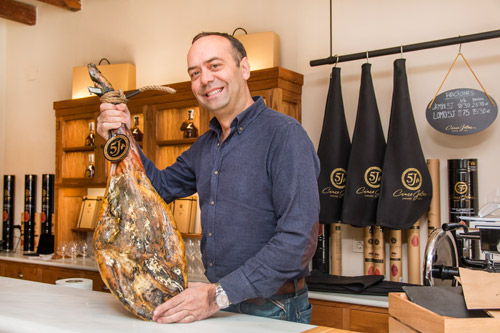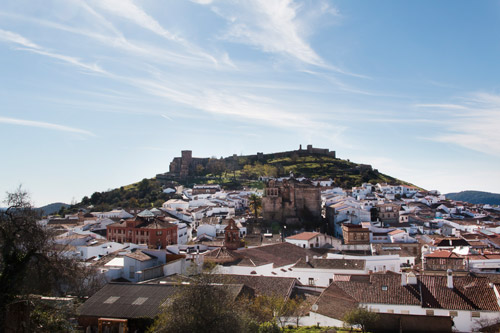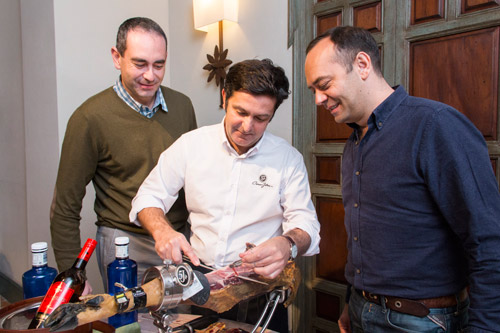Animal magic: the secrets of Ibérico ham
The ham produced by acorn-fed Iberian pigs hits every high for ham-lovers: it's the most labour-intensive, most expensive and the tastiest ham in the world. Fiona Sims travelled to the Dehesa in Spain with chef José Pizarro to see where the revered pigs roam
I'm with London-based Spanish chef José Pizarro and we're travelling in the Dehesa. We're about an hour northwest of Seville on empty roads in a magical landscape of rolling hills, wild flower-filled meadows and encina trees (or holm oaks) as far as the eye can see.
It's a unique, Unesco-protected ecosystem of prairie-like grazing land that once covered 90% of the country and now only remains in Salamanca, Extremadura, AndalucÁa, and just across the border in Portugal. And it's thanks to the Dehesa that this region produces the best ham in the world.
Or rather, it's largely thanks to the acorns (bellota) produced in the Dehesa. "Go on, try one," offers Pizarro, cracking the hard shell and prizing out the milky nut.
There are actually five different types of oak trees here, from the semi-naked Quercus Suber (cork oak) half-stripped of its bark for cork, to gall and kermes oaks, but it's the Quercus Ilex, or holm oak, that Iberico pigs favour for its juicy, sweet acorns.
"Hey, hey, hey, hey," calls farmer Juan Carlos Dominguez, opening the gate as the pigs lumber over, nudging our trousers inquisitively. "The breed dates back to the cavemen," he explains, gently tapping them away.
Only 5% of the Iberian pig livestock in this area are 100% Iberian acorn-fed pigs - the rest are a faster-growing mixed-race pig, so bear that in mind when you are buying your next ham.
Dominguez moves the pigs around every day. They clock up some 14km, each scoffing around seven kilos of acorns, in addition to three kilos of grass - they're the happiest pigs we've ever seen. "I can't live without JamÁ³n Ibérico," declares Pizarro.
Pizarro sells around 550 hams a year in his restaurants: José Tapas and Pizarro Restaurant on London's Bermondsey High Street, which he opened in 2011, and his latest place, José Pizarro Broadgate, which opened last summer.
He buys the ham from Cinco Jotas, the oldest outfit in town. Cinco Jotas pretty much put this ham on the map, opening the very first pure Iberian pig slaughterhouse in 1879 in the small town of Jabugo, where we travel to next. Many other producers followed - along with a rulebook of regulations and a pecking order of quality levels, with black label the best.
Jabugo, of course, has since become synonymous with Ibérico ham, and the town has become a magnet for ham lovers, who flock here by the coachload to cruise the ham bars and learn more about its labour-intensive production methods.
It takes, on average, six years to get this ham on the market: the pigs spend two years romping through the Dehesa, then a further four to five years hanging out in the town's cellars. Jabugo's USP is a microclimate with just the right balance of humidity that is particularly suitable for curing and ageing this ham.
"This is the cathedral of ham," says Pizarro, as we gaze in awe at the ranks of sweet-smelling ham hanging from specially constructed rafters in vast cellars at Cinco Jotas. Window vents are cranked open in a wonderfully low-tech effort to regulate the humidity, which all helps with the ageing process.
Aracena is the third rainiest place in Spain and a tad chilly on this crisp November day, which is surprising given how far south we are. But the hams need this combination of cold and humidity to enable them to dry out properly, explains Pizarro. Every three months each ham is brushed with sunflower oil to preserve its humidity.
"Touch is a big part of what they do, from opening and closing the windows, to covering each ham with salt, to testing whether the curing is complete. That knowledge is passed down to each generation," explains Pizarro.
Pizarro likes his ham with a particular cure. "Mine are cured a little longer than most, so the flavours are developed to the max," he explains. We nibble on an expertly carved leg, which has been smothered first in Andalucian sea salt before being hung out to dry for four years.
The depth of flavour is like nothing else,
lingering like a fine wine. The yellow ribbon of acorn-rich fat dissolves on the tongue in an umami-packed taste bomb.
A visit to the newly opened Cinco Jotas visitor centre costs 12 euros and lasts around one and a half hours, and includes a plate of ham and a glass of wine. Don't miss the Imax-style screen showing a movie of the pampered pigs roaming the Dehesa, especially if you don't get time to see the real thing.
From farm to plate
Jabugo is shortly to get its own Denomination of Origin (DO), we discover. It previously fell under the wider Huelva DO, but it got too big, apparently (the polite version of the story). The town is about a 20-minute drive west from the attractive market town of Aracena, the region's cultural hub and where we are based - and a two-hour drive north to Pizarro's hometown.
Pizarro comes from a small village called TalavÁ¡n in the neighbouring region of Extremadura, a rural area next to Portugal. "As a boy I wasn't allowed in the kitchen - I had to help my dad on the farm. Though I'd watch my mother bake bread, make gazpacho in the summer or arroz caldoso [rice stew] in the winter," he says.
"The food on our table was mostly ours, picked just a couple of hours before, such as melons and tomatoes, peppers and strawberries. We savoured the seasons - baby artichokes in the spring, green beans in the summer."
Pizarro didn't set out to become a chef. He trained as a dentist technician and, while he was waiting for a job, he did a cooking course in CÁ¡ceres and was hooked. "I thought I could juggle both careers, but the cooking was the bigger draw, so I gave up dentistry," he grins.
"When I first came to London 16 years ago, Spanish food didn't have the cachet of, say, Italian food, thanks to the country's isolation under General Franco and the poor reputation the cuisine had among tourists on the Costa del Sol. Indeed, there were few really good Spanish restaurants in London back then. That's all changed now, of course."
Thanks to importers, such as Brindisa, for whom Pizarro opened three restaurants, we now have access to premium Spanish ingredients and a growing number of excellent Spanish restaurants. In short, we don't mind paying for quality Spanish food - top Spanish ham, particularly.
OK, so it's not cheap - Pizarro sells the Iberico ham for £26 for 65g, but Pizarro reckons his customers understand the work that goes into it and are willing to pay for it. "It's an affordable luxury and, judging by the number of people who drop by for a glass of fino [dry Spanish sherry] and a plate of ham, my customers agree with me. But it has to be sliced correctly, and that's no easy task," says Pizarro.
You need to practice, and keep practicing, he says. He reckons it will take someone eight hours a day over five days, practicing on five hams a day, to master how to slice it. "It always tastes better when you know the carver has enjoyed slicing it," he adds.
José Severiano Sanchez enjoys slicing ham. He is Cinco Jotas's master carver, and he travels the world showing off his skills. "The 'punta' is the palest, sweetest bit of the leg, while the 'maza' is the darker bit in the middle that most people favour, and then there is the chewiest bit, the 'jarrete', nearest the hoof, where all the muscles come together, offering an explosion of flavour," he explains, giving us a little of each.
And it's not just the Iberico ham that Pizarro gets excited about. The fresh Iberico meat - particularly a cut called the pressa, is second on Pizarro's wish list. "You don't have this cut in the UK, as you can only get it on this breed of pig, but it's right next to the shoulder blade and it cuts like butter," he enthuses.
Pizarro is rather partial to Iberico pork ribs too, and we head out for dinner to his favourite place to eat them - José Vicente Restaurant in Aracena, where they are slow-cooked for five hours. They arrive, Flintstones-style, piled on to a large platter, after a plate of more ham, this time served over a dish of fried wild mushrooms with a sprinkling of fresh thyme.
Wild mushrooms are big here, along with peppers and pumpkins, and the cuisine shares similarities with Pizarro's home region a little further north and elsewhere. "There's a lot of influence from Portugal in the cooking here as it's only a few miles away. For example, coriander is used liberally - but it's very subtle," explains Pizarro, who dreams that one day he will own a 25-hectare finca here. "I'll just drink sherry and eat ham all day - what else is there?"
For more information about Cinco Jotas, go to cincojotas.com
Five great places to eat in Aracena
Restaurante Arrieros, Linares de la Sierra
Chef-proprietor Luismi LÁ³pez draws people to this tiny village from as far away as Seville for his modern Spanish cooking.
2 Calle de los Arrieros, +34 959 46 37 17, arrieros.net
Restaurante José Vicente, Aracena
Chef Jose offers some of the best traditional cooking in town. The slow-cooked Iberico pork ribs are a must.
53 Av. De Andalucia, +34 959 12 84 55
El Manzano, Aracena
This mushroom-themed restaurant offers more than 20 dishes made with the mushrooms of the region, which the owner, Manuel, picks every day in season.
Plaza Marqués de Aracena, +34 959 12 81 230
Restaurante Casas, Aracena
A locals' favourite, it's the best place to have a plate of jamÁ³n Cinco Jotas, washed down with fino, of course.
Calle Pozo de la Nieve, 37, +34 959 12 80 44
Puerta 20, Aracena
This newish bar and restaurant offers traditional cooking with a modern twist. Try the partridge pÁ¢té.
Plaza Marqués de Aracena, +34 959 09 93 50
Where to stay in Aracena
Hotel Convento Aracena
This hotel is a stylishly converted convent and the smartest bed in town. Doubles from £92 per night
+34 959 12 68 99, hotelconventoaracena
The Caterer Interview: Marcos Fernandez Pardo >>
Continue reading
You need to be a premium member to view this. Subscribe from just 99p per week.
Already subscribed? Log In


